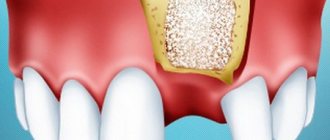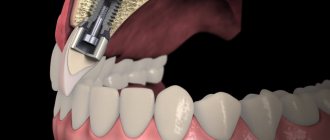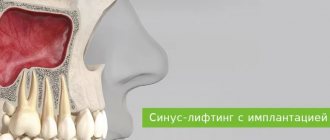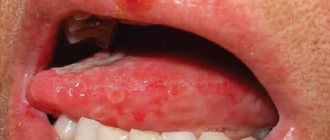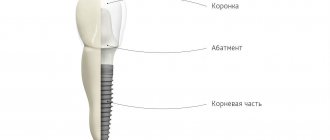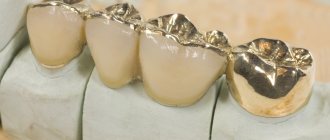What is a sinus lift?
Sinus lifting (sinus floor elevation) is a procedure for increasing bone tissue in the area of the maxillary sinuses. They are located on the upper jaw to the left and right of the nose. In most people, the roots of the chewing teeth of the upper jaw are initially located in the maxillary sinuses, so after the removal of these teeth there is not enough bone tissue to install an implant. Closest to the maxillary sinuses are the molars (sixth and seventh teeth), less often the premolars (fourth and fifth teeth), and sometimes the canines.
The orthopantomogram shows the boundaries of the bottom of the maxillary sinuses and the apex of the alveolar ridge. There is not enough bone tissue to install implants.
Implant installation methods
Installing implants allows you to replace missing teeth with new ones that are practically no different from natural ones. Today, there are several main options and ways to install an implant.
Classic implantation
Classical implantation allows you to insert implants in any quantity, even in the absence of teeth in the oral cavity. This process is very lengthy, however, in the end it gives an excellent result. The chewing function and aesthetics of the smile are completely restored. At the first stage of implant installation, artificial roots (the basis of the implants) are implanted into the bone tissue. Then the abutments (support for the crown) are implemented, and only after that it becomes possible to place a dental implant.
One-stage implantation - we will place the implant immediately after tooth extraction
In some cases, an implant can be installed immediately after tooth extraction, without waiting for the tissue to heal. This option allows you to prevent bone tissue atrophy, however, the operation can be performed only in the absence of any acute diseases of the teeth and gums in the patient.
Express implantation
In the case of express implantation, the implant and crown can be installed immediately after it is implanted into the bone. Place an implant
This method is possible provided that one or more teeth located at a distance from each other are restored. A combination of express implantation with other methods is often practiced, provided that express is used for the front teeth. It is possible to place a dental implant using the express method, provided that inflammatory diseases in the patient’s oral cavity have been treated, and there is no need to build up bone in the place of the missing tooth.
Indications
To install an implant, a minimum of 10 mm of bone tissue is required to the maxillary sinus. Otherwise, a rise in its bottom is shown.
1) If the distance to the sinus is 8-10 mm, it is possible to perform a closed sinus lift with simultaneous installation of implants. The term “closed” means that no additional incisions are required. This can be compared to endoscopic operations. The postoperative period is easier.
2) If there is bone tissue from 5 mm to 8 mm, an open sinus lift (classic version) is performed with simultaneous installation of implants. This technique creates access to the maxillary sinus from the cheek. Its mucous membrane is peeled off, lifted, and bone-substituting material is placed in the resulting space, which is absorbed and replaced with its own bone.
3) If the distance to the maxillary sinus is less than 5 mm, an open sinus lift is performed without installing implants. For immediate installation of implants, a sufficient volume of bone tissue is required in which they will be stabilized. If it is not enough, then the bone volume is first increased. After 6-9 months, implants are installed. After another 6 months, crowns are installed on the implants. With severe atrophy of bone tissue in the upper jaw, the treatment period can be more than a year.
Sometimes native bone is not enough
The bone of the upper jaw is more porous and, in the presence of a tooth, is penetrated by a system of capillaries that nourish the bone. If a patient removes a tooth and does not think about installing an implant immediately, then after 6 months thinning of the bone tissue is observed.
This occurs due to the absence of a tooth, which was responsible for the functioning of the bone. The absence of a tooth root leads to a lack of chewing load, the “feeding” of blood stops and the spongy substance becomes thinner. After a year, subsidence reaches its peak and when installing an implant or bridge, a sinus lift of the jaw will absolutely be required.
At the same time, in elderly patients, thinning occurs even from the side of the maxillary sinus - from the inside.
You can avoid the consequences by installing an artificial dental implant in place of the extracted tooth within a period that will not exceed six months after surgery.
Types of surgery
Indications for a sinus lift are a lack of bone tissue, and even if one millimeter is not enough to securely install a new six, for example, the matter cannot be done without surgical intervention.
Additional Information. According to available statistics, 80% of patients suffer from a lack of maxillary ridge height. The risk group includes people who lost their teeth more than six months ago, suffering from periodontal disease and cysts. In addition, thinning bone tissue is sometimes a congenital feature.
The type of manipulation depends on the size of the missing tissue.
Closed operation
A closed sinus lift is a simpler type of surgery that is easier for the patient to tolerate. Includes several steps:
- Creation of several holes in the gum that are drilled into the bone. It is important at this stage to act carefully and not damage the sinus membrane, so specialists use data from computed tomography or 3D images;
- Insertion of instruments through the resulting holes and displacement of the bottom of the sinus;
- Filling the cavity with bone tissue;
- Installation of implants immediately after thickening the bone - they are installed inside the sinus, simulating the roots of the teeth, and plugs are screwed onto them from the outside;
- Suturing of the gums takes up to 10 days, the period depends on the size of the operation area.
The use of this method is possible only if the thickness of the “native” bone is sufficient, from 5 mm. In this case, it is possible to install three root implants at once.
The formation of a pocket for filling is carried out either using a balloon ball, which, when inflated, creates the required volume (the safest method), or with hand tools using a mechanical method.
Open surgery
Open sinus lifting is a complex, full-fledged surgical intervention, which is performed when there is significant thinning of the tissue (more than 6 mm) and in the absence of three or more teeth in the dentition.
Procedure of manipulations:
- Detachment of gingival matter. The doctor carefully pries and lifts the thin gum to get to the bone;
- Osteotomy - drilling out a small section of bone to open access to the maxillary sinus;
- Lifting the sinus membrane from the inside and filling the formed pocket with bone tissue.
Creating a space in the bone can lead to perforation of the meningeal sinus. In this case, the doctor either sews up the holes and continues working, or applies stitches and postpones further actions until after healing.
Next, the dental surgeon decides to immediately place an implant if there is a slight lack of bone, or:
- add bone material;
- apply a membrane;
- cover the bone with gum;
- apply stitches.
After the new materials have implanted, the patient returns after 3-4 months to have implants installed.
Contraindications
Any surgical intervention has contraindications and sinus lift surgery is no exception.
Absolutely prohibited:
- clotting problems and other disorders of the heart and circulatory system (including heart failure);
- various diseases of the immune system, including AIDS and HIV (can lead to implant rejection);
- hormonal diseases (thyroid problems and diabetes);
- recent chemotherapy or radiation therapy;
- oncological diseases in the active phase of treatment;
- any bad habits such as alcoholism, smoking, etc.
There are also relative contraindications that can be addressed before lifting surgery:
- acute viral infections;
- ENT diseases in the acute phase;
- dental caries and stomatitis.
Important! Hold off on manipulations for colds, especially those accompanied by a runny nose. First - health, then - implants.
Thus, before going to the surgeon, it is necessary to sanitize not only the oral cavity, but also the entire body.
If lifting is still contraindicated for the patient, then shorter implants and a conditionally removable prosthesis can be installed.
Materials used
Material for bone tissue augmentation can be:
- Autograft is the patient’s native bone, which is obtained by cutting from the lower jaw or chin. Afterwards, the material is crushed and the pocket formed by raising the sinus is closed. This material prevents rejection by the immune system, engraftment is ideal, however, the downside is the high risk of injury - you need to wait for two surgical sites to heal, especially if a lot of material is required for filling.
Attention! Internal components thin out faster and in this case additional augmentation will be required.
2. Materials of animal origin, which are obtained from samples of bones of cattle. In this case, after grinding, the substance undergoes mandatory sterilization and removal of impurities (collagen) for drying. The resulting crumbs can be adjusted to the required size by pressing into blocks. This material has a good survival rate and low cost, so it is most common among surgeons. The animal components begin to interact with the tissues that surround them, forming new bone and being resorbed when the job is done.
On a note! Often, animal tissue is mixed with autograft to reduce the cost of surgery.
3. Artificial fabric - consists of synthetic fibers - granulate or calcium phosphate. The composition contains a replacement for the building bone substance - hydroxyapatite. The action is similar to the animal component; after bone growth, resorption occurs. Modern materials are high cost, but stimulate an active regeneration process, as well as biocompatibility.
The choice of material depends on several factors:
- the amount of bone tissue to be inserted into the sinus;
- the capabilities of the patient's lower jaw;
- funds available to a person.
What happens after
Complications after a sinus lift are possible, since this manipulation is considered a full-fledged surgical intervention. The only question is how to avoid most of them and prepare for treatment.
Medical errors
They can be avoided if you choose a trusted clinic. Choose carefully who you trust with your jaw to avoid:
- Incorrect choice of augmentation method (this can happen due to illiterate diagnosis and determination of bone tissue thickness), resulting in rapid rejection or destruction of the implant;
- Violation of operation technology and sanitary standards.
The dentist’s inexperience may also manifest itself during the manipulation process:
- perforation of the sinus wall - this requires urgent suturing of the film or application of collagen material, you need to act quickly and accurately;
- in turn, undetected perforation leads to the entry of bone tissue into the maxillary sinuses, which in the future will manifest itself as constant congestion, sinusitis and other complications;
- bleeding is a common situation, but can unsettle you;
- infection in case of non-compliance with epidemiological rules, which leads to tissue suppuration, chronic infectious diseases of the respiratory tract and the formation of cysts.
Reviews from patients and friends will help you avoid “medical” complications after a sinus lift. Approach this with full responsibility.
Patient unconsciousness
Choosing a good clinic is not enough. It is important to follow all the recommendations given by the specialist after the operation, and also not to withhold information at the stage of collecting anamnesis and diagnosis. Violation of these principles will lead to:
- inflammation of the sinuses;
- uncontrolled bleeding during and after manipulations;
- suture infection and bone inflammation;
- rejection or slight mobility of implants;
- pushing artificial materials deep into the jaw (in case of violation of nutritional rules);
- loss of transplanted tissue due to severe sneezing and coughing;
- ENT complications.
Recommendations
The list of tips for maintaining the desired effect is quite extensive, here are the main points:
- take prescribed medications on time, especially antibiotics and anti-allergy drugs;
- follow a certain diet - only soft and warm food in the first weeks before the sutures are removed, chew on the healthy side to avoid unnecessary stress;
- Avoid physical activity until the sutures are removed, then only light exercise for up to a month;
- If possible, avoid air travel;
- to avoid swelling after sinus lifting, it is necessary to avoid visiting the pool and saunas;
- do not create unnecessary tension in the nasal cavity - try to sneeze, cough and blow your nose less.
Inconvenience can be avoided if an implant is placed in time to replace the extracted tooth. But, if there are indications and time has passed, select a reliable specialist and then everything will go well.
Contraindications
In addition to general contraindications (type 1 diabetes, recent radiation therapy, etc.), there are a number of factors that may carry additional risks for the operation. The most common limitation is inflammatory diseases in the maxillary sinus area. It is necessary to identify the source of inflammation. Additional consultation with an ENT specialist may be required. Some difficulties may be due to previous operations in the area of the maxillary sinuses.
Diagnosis before surgery
To properly plan the procedure and select the optimal one, it is necessary to undergo diagnostics. An important step is to refer the patient for a computed tomography (CT) scan - this way the doctor will have a complete picture of the structure of the upper jaw and maxillary sinus, as well as the exact measurements of the thickness of the bone and sinus membrane. Additionally, blood tests are required, at a minimum - general clinical and to determine glucose levels. If certain diseases (endocrine or cardiovascular) are detected or present, you will need to consult a specialized specialist and prescribe therapy.
Open
The first step is to numb the surgical site. Local anesthesia, as for dental treatment. The procedure itself is painless.
At the second stage, an incision is made in the gum in the area of the missing teeth. The gum itself moves upward, exposing the underlying bone tissue. Then access to the maxillary sinus is created. With the help of special instruments, the wall of the maxillary sinus is thinned, limiting it from the oral cavity. The inside is lined with mucous membrane (Schneiderian membrane). During surgery, the mucous membrane peels off and rises.
Bone replacement material is placed in the resulting space, which eventually dissolves and is replaced by its own bone.
Despite the apparent complexity of the procedure, open sinus lift has several advantages. It is possible to significantly increase the volume of bone in the maxillary sinus area, even in cases where the distance to it is only 1 mm. The operation is performed under direct vision control, so the implant surgeon can take into account all anatomically complex areas and avoid complications, for example, rupture of the mucous membrane of the maxillary sinus.
Open sinus lift with immediate installation of implants.
Modern drugs for anesthesia in dentistry are completely safe and do not cause complications
Numbness after local anesthesia lasts only a couple of hours, and patients recover from general anesthesia immediately. The risk of an unfavorable outcome is usually not due to side effects of the drug, but to drug inconsistencies and incorrect training of the anesthesiologist, which occur very rarely.
Levin Dmitry Valerievich
Chief physician, Ph.D.
Closed
Unlike the open one, the closed version is carried out only simultaneously with the installation of implants. The gum incision is the same as for conventional implantation.
First, preparations are made for implant installation. A bed for the implant is formed. Then a special instrument is installed through it, it is called an osteot, with the help of which the bottom of the maxillary sinus is raised. After raising the bottom, the implant is installed.
The advantages of this method are the minimal invasiveness of the procedure and an easier rehabilitation period. However, in this case it is possible to raise the bottom of the sinus only by 2-3 mm. If you try to perform a closed sinus lift with a fundus elevation of 4-5 mm, there is a risk of rupture of the mucous membrane of the Schneiderian membrane.
First, a bed is formed for installing the implant. Through it, the bottom of the maxillary sinus is raised. The procedure involves one-stage installation of implants.
Recommendations after implant installation
- During the first 2-3 hours after surgery, eating is strictly not recommended. What happens if you neglect this? Disastrous consequences include: sutures coming apart, infection of the titanium rod installation site, biting the tongue or cheek.
- On the day of surgery, you do not need to brush your teeth or rinse your mouth. Starting from the second day, you can clean them, but with a soft brush. It is better not to touch the operated area. You can also rinse your mouth with an antiseptic solution after eating, but very gently.
- For the first two to three days, you should strictly not consume hot/cold food or drinks. It is recommended to exclude sour and spicy foods from the diet. You can eat broths, yogurt, and pureed foods.
- For 2-4 weeks, avoid air travel, saunas, increased physical activity, and hypothermia. Otherwise, the risk of implant rejection increases.
- Completely stop smoking and drinking alcoholic beverages for at least five days. During the period of osseointegration of implants (3-6 months), reduce the number of cigarettes smoked to a minimum.
Compliance with the following rules will not only help shorten the rehabilitation period, but will also minimize the risk of complications.
Implantation without sinus lift
Many well-known brands of implants have reconsidered their position regarding bone grafting and are offering solutions that allow the installation of implants without additional operations to build up bone tissue. When the bone volume is insufficient, it is possible to install a shorter implant without performing a sinus lift.
Straumann offers implants with a length of 4 mm. According to studies, the length of the implant does not matter if the installation protocol is followed. Thus, it is possible to avoid additional surgical procedures by installing a shorter implant.
This approach has its limitations, and in all clinical cases it is not possible to install implants without osteoplasty. If a large number of teeth are missing, it is possible to install extreme implants at an angle of up to 45 degrees, bypassing the maxillary sinuses. Implants of the required length are installed without bone tissue augmentation. Read more about this technique in the article about All-on-4.
The distance to the maxillary sinus is 7 mm. Instead of performing a sinus lift, a short Ankylos implant (Germany) 6.6 mm long was installed without additional surgical procedures.
Recovery period
Even if the procedure was successful, complications may arise in the first few days, especially if the patient neglects the doctor's advice. Until the soft tissues heal, it is recommended to eat soft or liquid food at a comfortable temperature. Eating hard, rough foods or hot food can damage the wound.
You should not smoke, as nicotine constricts blood vessels and tissues heal worse. In the first week, you should not overheat the body, engage in sports or heavy physical labor, otherwise bleeding may occur. It is better to sleep on the side where no surgical procedures were performed.
Rehabilitation period
On the day after surgery, pain is possible, which can be relieved by taking anti-inflammatory painkillers (Nurofen, Nice, Nimesil). Starting from the next day, the need for painkillers is much less, 1-2 tablets per day for 2-3 days is enough. Swelling may occur in the surgical area. The swelling increases for 3 days, and begins to subside on the fourth. Therefore, it is not recommended to heat the surgical site or engage in physical labor for several days after a sinus lift. Nasal congestion may occur, which can be relieved with vasoconstrictor nasal drops. To prevent complications, it is recommended not to fly on an airplane for 1-2 weeks after osteoplastic surgery. This is due to the pressure difference in the plane, which theoretically can lead to a violation of the integrity of the mucous membrane of the maxillary sinus.
If a sinus lift was carried out with the immediate installation of implants, then on average after 6 months crowns are installed on them. If there was large atrophy of bone tissue, and the operation was performed without installing implants, then the waiting period is 6-9 months.
Possible complications
Sinus lifting of the upper jaw is safe if it is performed by a specialized dentist in a clinic with the necessary equipment. However, in some cases, negative consequences may occur both during the operation itself and during the rehabilitation period:
- perforation of the maxillary sinus;
- pushing the implant into the sinus;
- development of acute sinusitis, which, if left untreated, can become chronic;
- poor fastening, mobility of the structure;
- wound infection;
- bleeding from the nose or wound;
- implant rejection.
Immediately after the procedure, swelling, pain, and redness of the mucous membranes occur. Body temperature may increase. These phenomena go away on their own after a few days. To alleviate the condition, you can take analgesics, antipyretics, and rinse your mouth with antiseptics.
If infection or damage to soft tissue occurs, complications become apparent within the first 3 days. If the temperature rises, pain or swelling increases, you should consult a doctor.
What bone replacement materials are used in sinus lifting?
The reference material for sinus lifting is the patient’s own bone. It has maximum regenerative potential and absolute biocompatibility. However, to get your own bone you need to get it from somewhere. This is the disadvantage of this method, because... it is more traumatic. In addition to surgery in the maxillary sinus area, it is necessary to perform a second operation to obtain your own bone tissue. Most often it is obtained from the angle of the lower jaw, or from the chin area.
There are bone replacement materials that give a similar result as the patient’s own bone. They are produced in the form of granules and are obtained from the bones of cattle, or are completely synthesized. These are absolutely safe materials, the most famous of them is called Bio Oss from the Swiss company Geistlich. The mechanism of action of bone replacement materials is that they create the basis for the germination of one’s own blood vessels and cells. Over the course of 6-9 months, bone replacement materials gradually dissolve, being completely replaced by the patient’s own newly formed bone.
Is this surgery expensive?
It is difficult to say definitively how much a sinus lift costs. This depends, for example, on the region where this operation is performed. But here’s what’s surprising: the doctor’s qualifications, which should make the procedure more expensive, often work in the opposite direction: a doctor who is confident in his abilities does not waste extra time and is able to see more patients. Therefore, he does not charge exorbitant prices and does not scare away his clients with them. In general, the price for a sinus lift cannot be as high as for installing an implant. The only exception can be an operation in which both bone augmentation and implant installation are performed simultaneously.
The price of a sinus lift itself depends on the volume of material being built up and its nature. It could also be the patient’s own bone, which is worth nothing to him. You will only have to pay for the procedure of “mining” this bone. In another case, a high-tech synthetic material may be used, which has a certain cost.
Sometimes a doctor has to redo something that was done in bad faith in another clinic. And this can lead to a serious increase in the cost of the operation.
Platelet Rich Plasma
To stimulate the growth of the patient's own bone, PRP technology is used - platelet rich plasma - platelet rich plasma. Before the sinus lift begins, a test tube of blood is taken from a vein. It is placed in a centrifuge, in which it is separated into fractions within 12 minutes, one of which is platelet-rich plasma. Using this method, it is possible to obtain bone growth factors. Unlike collecting your own bone, which also contains growth factors, obtaining a tube of venous blood is much easier. By using the patient's own blood, the risks of incompatibility and allergic reactions are eliminated.
Contraindications for extensions
There are certain conditions and diseases of the oral cavity for which osteoplastic surgery is prohibited. Such diseases include:
- Malignant tumors of the cheeks, gums, throat.
- Disorders and diseases of the blood clotting system.
- Poor functioning of the cardiovascular system.
- Immune system disorders, HIV, AIDS.
- Acute stage of sinusitis of the maxillary sinus, polyps of the nasal cavity, multiple septa.
- Recovery period after nasal surgery.
It is also not recommended to perform extensions on patients suffering from alcoholism and drug addiction. This is associated with impaired clotting time and poor blood clot formation, which increases the risk of post-operative bleeding. Patients with hepatitis C are allowed sinus lift, since the disease does not affect the process of bone tissue regeneration and the survival of implants.
Various techniques
One of the most common complications is rupture of the maxillary sinus membrane. It occurs during an open sinus lift, when access to the maxillary sinus is created, or during its membrane peeling. Therefore, burs and cutters have been developed that do not injure the membrane of the maxillary sinus even if they accidentally touch it.
Another option is an endoscopic sinus lift . It is carried out without additional incisions, like a closed one, but with its help you can significantly raise the bottom of the maxillary sinus. With the usual closed version, monitoring the condition of the membrane is carried out only tactilely, therefore, using this method, the bottom of the sinus does not rise more than 2-3 mm. But under the visual control of an endoscope, it is possible to expand the indications and conduct a closed sinus lift even in cases where an open one is indicated.
The main advantages of the endoscopic method are low trauma and an easy postoperative period. Only a few clinics have the necessary expensive equipment to carry out such a procedure.
Standards for sinus lifting in our Center
Regardless of the method used to perform sinus lift, we did everything possible to ensure that the operation was successful without complications. For all types of surgical operations, incl. and for sinus lifting, our Center provides a lifetime guarantee.
We have eliminated the risks of possible errors at each stage of the operation:
- Ultrasound protocol PiezoSurgery® Piezosurgery is the standard of modern dentistry. When creating access to the maxillary sinus, the bone is not sawed out, drilled or broken out, but is delicately softened. The Center uses the NSK VarioSurg device, which turns off when approaching soft tissues - nerves, blood vessels, sinus mucosa. Which eliminates ruptures, perforations and perforations.
- Operating microscope All stages of the operation are performed under multiple magnification of a Seiler dental microscope. Increases visibility of the surgical field, helps the surgeon see even the finest structures, visually control actions in the smallest detail to avoid deviations from the standard protocol.
- Lift-Control Micro Instrument Set To work with the Schneiderian membrane (sinus lining), a coordinated set of instruments are used in a specific sequence. This allows the surgeon to most delicately and carefully separate the membrane from the bone plate without tearing or damaging it.
- Bone growth stimulants We use only original certified bone replacement drugs, which are completely biocompatible and do not cause allergies or rejection. KEYSTONE's protein and collagen bone morphogenetic proteins (BMPs) stimulate bone tissue growth using the body's reserve forces.
Sinus lifting with sedation - comfort for anxious patients and salvation for heart patients
We perform the operation in medicated sleep. Immersion in a controlled sleep allows you to undergo a necessary but exciting procedure without pain, fear and nervous overload. This is especially important for patients with cardiovascular diseases to avoid pressure surges. Our staff anesthesiologist-resuscitator will select the optimal “cocktail” of sedatives and condition-correcting drugs. After the operation, you will not be haunted by dizziness and clouding of consciousness - this is not general anesthesia . The drugs are completely safe for the body, after 30-40 minutes you can go home. We will not keep you in the clinic unnecessarily; hospitalization for 2-3 days is not required.
Levin Dmitry Valerievich
Founder and Chief Doctor of the Center
How to avoid risks and complications?
Although the sinus lift has been used worldwide for over 30 years, it is a technically challenging procedure. Additional complications may arise from anatomical formations in the maxillary sinus, for example, septa dividing the sinus into several cells. The membrane can be so thin that it ruptures during a sinus lift from a banal exit through the nose.
How to avoid health risks if you are indicated for a sinus lift? The main thing is to trust a qualified implantologist who will take the correct treatment tactics even in a difficult case. Be prepared for the fact that the treatment period for severe bone tissue atrophy can be significant, a year to a year and a half.
The best bone grafting is the one that doesn't take place. If it is possible, without compromising the reliability of the treatment plan, to avoid bone grafting, then you can install shorter implants or bypass the maxillary sinus by installing implants at an angle.
Are there any alternative solutions?
The need for a sinus lift does not arise in all cases. It will not be required if dental restoration is carried out using basal implantation technology, which uses a special type of implants.
There is no need for a sinus lift when using All-on-4 implantation technology. But there is one caveat: surgery according to this protocol is applicable only to patients with a completely toothless jaw.
Would you like to receive detailed advice on sinus lifting from qualified and experienced specialists? Come to an appointment with the doctors at our clinic in Moscow - “Aesthetica”! The initial consultation with a specialist is free and during the consultation you will receive detailed answers to all your questions about dental implantation.
To make an appointment, you just need to dial our clinic’s phone number or leave a request for a call back on our website.
Take a short test and calculate the cost of treatment!
Take a short test
- Selection of implants
- Which tooth is missing?
- How long has the tooth been lost?
- Missing teeth
- Cost calculation
×
Manukyan Artavazd Genrikovich
Chief physician of the clinic
Articles on the topic
What tests to take before dental implantation in Moscow
The necessary tests for dental implantation are determined individually after the initial examination.
The doctor takes into account the condition of the oral cavity and the presence of concomitant chronic diseases...... Read #dental implantation
Nobel implants – Nobel Biocare, turnkey price, reviews, installation
Nobel implants are developments of the Swiss manufacturer Nobel Biocare, celebrating their half-century anniversary.
Biocare is rightfully considered one of the leading implant manufacturers. Nobel products….. Read #dental implantation
Turnkey dental implantation: description of the procedure, features and benefits for patients
Implantation is a modern and effective method of restoring lost teeth.
During the operation, the patient is implanted in the area of the lost tooth with an implant - an artificial root, onto which it is then fixed..... Read #dental implantation
Implantation of chewing teeth: subtleties of the process, technology, prices
We will tell you about implantation of chewing teeth in this article.
After reading the material, you will learn about the features of implantation of chewing teeth, what implants and crowns are needed….. Read
Sinus lift and sinusitis
Often people accidentally find out that they have problems with the maxillary sinus. This usually happens during a routine examination at the dentist, when an orthopantomogram is taken for another issue and the doctor notices in the image that the mucous membrane of the maxillary sinus is thickened.
What to do in this case? No need to panic. There are many reasons for thickening of the maxillary sinus membrane, and not all of them require any additional treatment. The simplest thing is that the picture was taken at a time when the patient was infected with ARVI. A cold can cause the lining of the maxillary sinus to thicken as the body's response to illness. It is necessary to repeat the picture some time after complete recovery, and only then can conclusions be drawn.
In any case, it is recommended to obtain additional advice from an ENT specialist who will accurately determine the nature of the thickening of the maxillary sinus membrane. In the absence of inflammatory phenomena, there are no contraindications for surgery. Otherwise, an additional course of treatment for the maxillary sinuses may be required.
Sinus lifting under local anesthesia, general anesthesia or sedation
Any bone grafting is in most cases performed under local anesthesia. Sinus lifting is no exception, but in some situations it is necessary to change the type of anesthesia in the direction of increasing the analgesic effect.
For local anesthesia, the most modern and safe painkillers are used. Sometimes sedatives are added to anesthesia if the patient is terrified of the procedure or is prone to strong feelings. The main problem with such medications is the risk of an allergic reaction. Some groups of patients must undergo a small and painless skin test before administering the product, which helps to exclude intolerance. If the reaction to a provocative test is positive or questionable, then the doctor refuses the incompatible anesthetic and selects a compatible one.
Sinus lifting can be performed under general anesthesia, especially for open surgery. Such anesthesia is required for patients with an excessive gag reflex and people with contraindications to local anesthesia. General anesthesia is also performed during operations in hospitals, if hospitalization is required, or at the request of the patient, if he is afraid of surgery.
Price
The price of a sinus lift consists of the work of the implantologist, as well as the cost of bone replacement materials.
The average cost of a sinus lift is 30-70 thousand rubles.
A closed sinus lift, especially with a slight elevation of the bottom of the maxillary sinus, can be performed without the use of additional bone replacement materials.
| Expert, author of the article: Akhtanin Alexander Pavlovich Orthopedic dentist, implantologist 35 years of implantation experience Material updated: October 11, 2022 |
The essence of the procedure
After the removal of the upper teeth, weakening and thinning of the bone tissue occurs. The lower edge of the maxillary sinuses is located next to the tooth roots, so if they are absent, the bottom descends to the bone. As a result of these two changes, it becomes impossible to secure a dental implant without damaging the soft tissue of the inside of the nose. In addition, the bone becomes fragile and cannot provide reliable fixation of the structure.
With the help of a sinus lift operation, both problems are solved - the thinned bone acquires the required volume, and the bottom of the maxillary sinus is raised due to the augmented material. This can be autologous bone (the patient’s biomaterial) or artificial bone fillers. The second option is more often performed, since it is less complex and painful. Depending on the characteristics of osteoplasty, implantation is carried out immediately or after a period of time.
